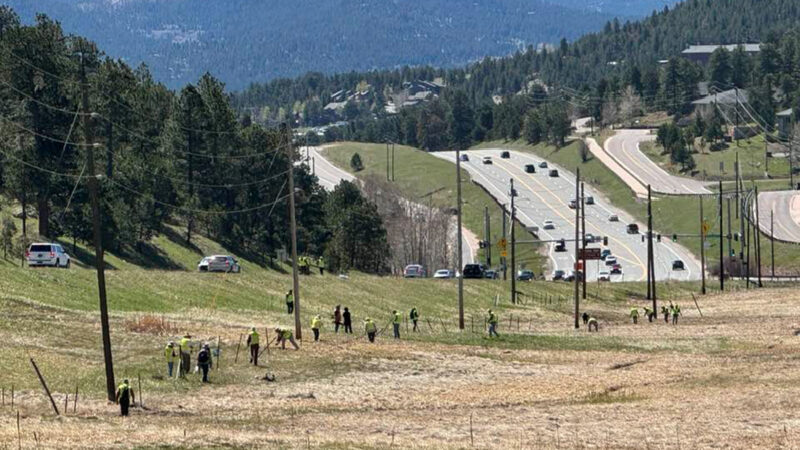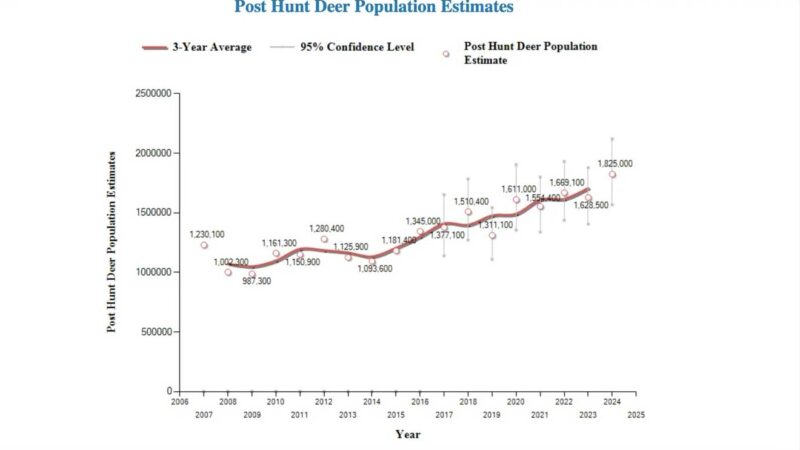The Best Camp Shoes of 2025
We may earn revenue from the products available on this page and participate in affiliate programs. Learn More ›
Whether you’re backpacking or camping, a great pair of camp shoes is the perfect cap to a long day in the backcountry. I’ve worn dozens of different shoes on all manner of trips, from river rafting in Colorado to car camping in the Olympics to backpacking in Arizona, and it’s given me an appreciation for how much a great pair of shoes can elevation your experience. To help you find the best camp shoes for your planned adventure, I’ve evaluated top picks from Crocs, Vivobarefoot, Merrell, The North Face, and more.
Best Overall: Merrell Hydro Moc (Men’s) (Women’s)
↓ Jump to Review
Lightest: Xero Z-Trail EVs (Men’s) (Women’s)
↓ Jump to Review
Best Sandals: Luna Middle Bear Sandals (Unisex)
↓ Jump to Review
Classic Pick: Crocs Classic Clog (Unisex)
↓ Jump to Review
Best for River Crossings: Vivobarefoot Ultra III Bloom (Men’s) (Women’s)
↓ Jump to Review
Best for River Trips: Bedrock Cairn Adventure Sandals (Men’s) (Women’s)
↓ Jump to Review
Best for Cold Weather: The North Face ThermoBall Traction Mules (Men’s) (Women’s)
↓ Jump to Review
Forever Pick: Birkenstock Arizona (Men’s) (Women’s)
↓ Jump to Review
Best Budget: Generic Flip Flops (Men’s) (Women’s)
↓ Jump to Review
Vibram Furoshiki (Men’s) (Women’s)
↓ Jump to Review
Oboz Whakata Puffy (Men’s) (Women’s)
↓ Jump to Review
How I Tested the Best Camp Shoes
I’ve been camping, backpacking, and thru-hiking for years, and so have first-hand experience with just how important my feet are to getting after it. Recovering after a long day in the backcountry is key, and your footwear choice will determine what your next day looks and feels like.
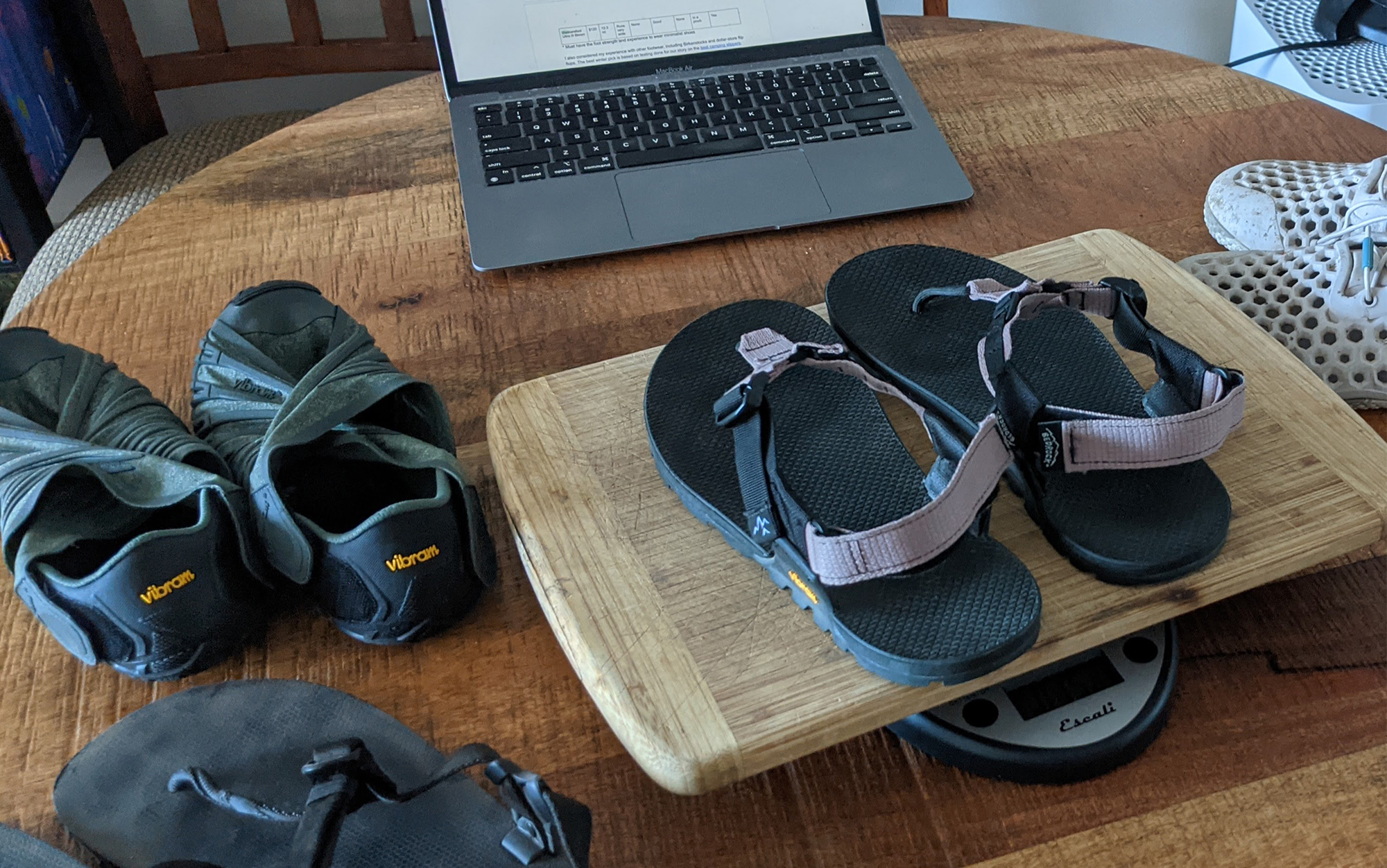
To test the best camp shoes, I considered weight, cushioning, breathability, arch support (or lack thereof), ability to use for hiking in a pinch, functionality as a water shoe (for river crossings), and width, since feet tend to expand during backpacking trips. Here are the results:
| Camp Shoe | Price | Weight* | True to size? | Cushioning | Breathability | Arch Support | Could be used for | |
| Hiking | Water Crossings | |||||||
| Bedrock Cairn Adventure Sandals | $115 | 15.2 ounces | Runs wide | None | Great | None | Yes** | Limited |
| Birkenstock Arizona | $110 | 16 ounces | Runs slightly wide | Minimal | Great | Medium | I wouldn’t | Limited |
| Crocs Classic Clog | $50 | 10.9 ounces | Runs wide | Medium | Good | Minimal | In a pinch | Limited |
| Merrell Hydro Moc | $60 | 14.6 ounces | Runs wide | Medium | Good | Medium | In a pinch | Yes |
| Luna Middle Bear Sandals | $120 | 14 ounces | Runs wide | None | Great | None | Yes** | Limited |
| Oboz Whakata Puffy Slippers | $100 | 18.2 ounces | Runs slightly wide | Low | Poor | Minimal | I wouldn’t | No |
| North Face ThermoBall Traction Mules | $59 | 14 ounces | True to size | High | Poor | None | No | No |
| Vibram Furoshiki | $115 | 11.6 ounces | N/A | None | Poor | None | I wouldn’t | Limited |
| Vivobarefoot Ultra III Bloom | $120 | 12.3 ounces | Runs very wide | None | Good | None | In a pinch | Yes |
| Xero Z-Trail | $80 | 8.3 oz | True to size | None | Great | None | Yes** | |
**Must have the foot strength and experience to wear minimalist shoes
Best Camp Shoes: Reviews & Recommendations
Best Overall: Merrell Hydro Moc
Pros
- Comfortable
- Affordable
- Can be used for river crossings
Cons
- A bit dorky looking
Key Features
- Available Sizes: Men’s 7-15, women’s 5-11
- Materials: Injected EVA foam
- Weight: 14.6 ounces
- Moderate arch support
This is the do-it-all camp shoe. First off, it’s comfortable and roomy. At the end of the day, when your feet have been banged up by a full day of backpacking, the smooth, cushioned sole of these shoes, coupled with its wider-than-usual interior will feel good to your feet. They are easy to slip on and off, a boon during that midnight bathroom break. The inclusion of a true back heel (unlike the Crocs Classic) makes the Merrell Hydro Mocs secure enough for all but the gnarliest river crossings. (Indeed, it was the winner of our best camp shoe award when we tested the best water shoes for hiking.)
They are even affordably priced, one of the few camp shoes we looked at to come in at well under $100. And you can feel good about their eco bonafides, as 10 percent of the shoe is made from Bloom, a foam derived from algae. The algae was harvested from waterways around the world where an excess in algae (which can occur as a result of both rising temperatures and agricultural runoff) has the potential to result in toxins entering waterways.
Lightest: Xero Z-Trail EVs
Pros
- Very lightweight
- Affordably priced
- Comfortable
- Enough traction for snow and scree
Cons
- Not durable enough for long-term hiking
- Minimalist design requires strong feet to use
Key Features
- Available Sizes: Men’s 6-15, women’s 5-12
- Materials: Polyester, foam, rubber
- Weight: 8.3 ounces
- No arch support
I’ve never had to test the versatility of a camp shoe to the extreme more than OL’s 2024 Backpacking Gear Test. After the trail runners I was testing weren’t a good fit for me, I hiked the last 20 miles in the Xero Z-Trail EVs. While my feet were aching by the end, after two days of scoring the best ultralight backpacking gear, I was back on trail. The impressive lugs on these keep me stable on shifting rock, stream crossings, and on snow.
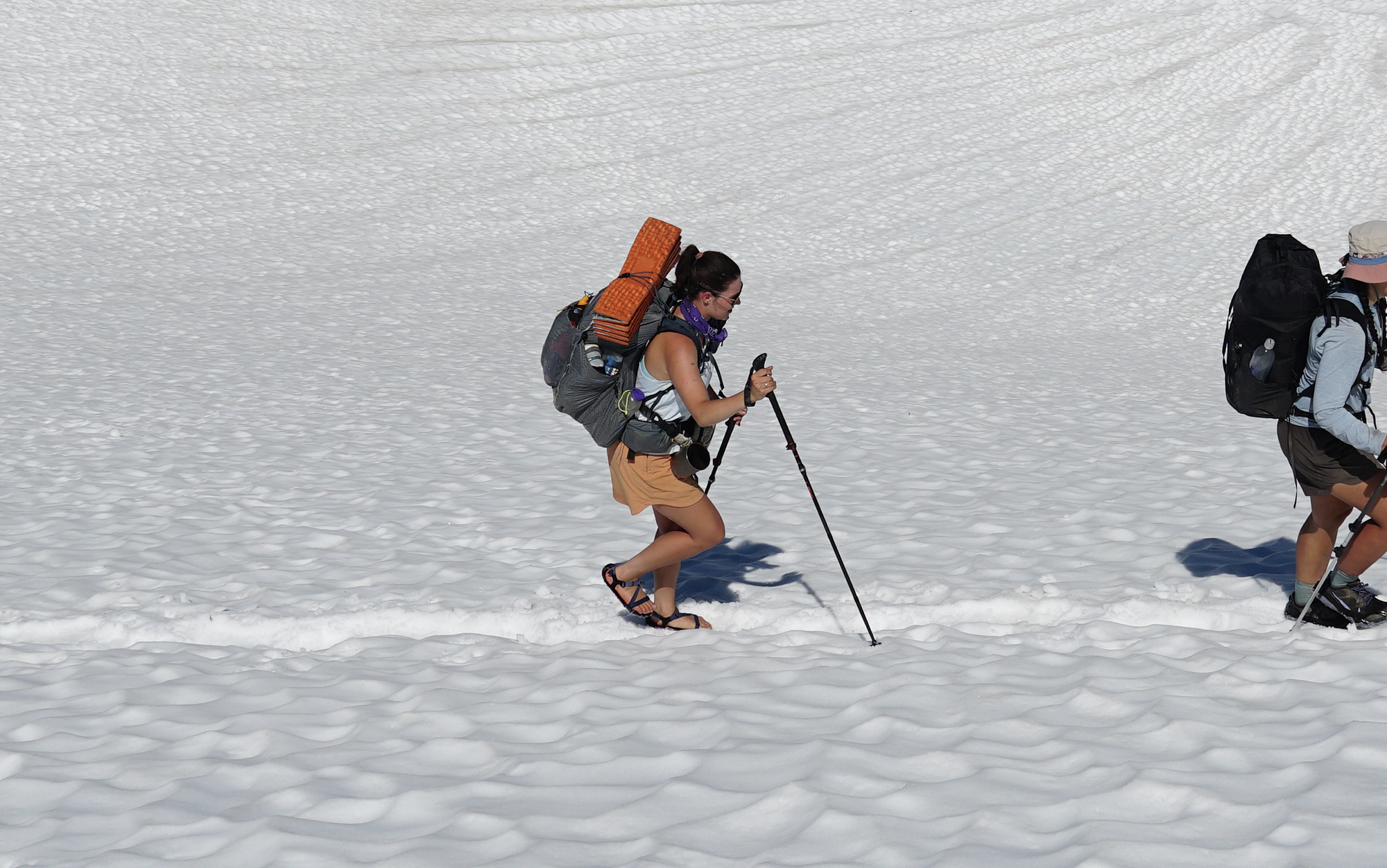
However, this is an extremely minimalist sandal with almost no protection or support. My pair experienced quite a bit of wear after 20 miles on the PCT. But as a camp shoe, it’s extremely light, versatile enough to explore around your site, and most importantly lets you ditch your sweaty hiking shoes at the end of the day.—OL associate editor Ashley Thess
Best Sandals: Luna Middle Bear Sandals
Pros
- Comfortable footbed and back heel strap
- Can be used for water crossing and some hiking
Cons
- Y-strap gets twisted easily
- Adjusting the back heel strap takes some torque
Key Features
- Available Sizes: Men’s 4-13; women’s 6-12
- Materials: Vibram rubber (outsole)
- Weight: 14 ounces
- No arch support
The Luna Middle Bears are very nearly the perfect sandal. While similar at first glance to the river-ready Bedrock Cairn Adventure Sandals, their footbed is far more comfortable over the long haul, with a smooth finish that somehow still sticks to your feet the just-right amount. The padded straps are very soft and comfortable, and I have enjoyed their feel both wearing them loose on a sandy beach outing and strapping them snug so I can race my 5-year-old across the grass. hugged my heel better.
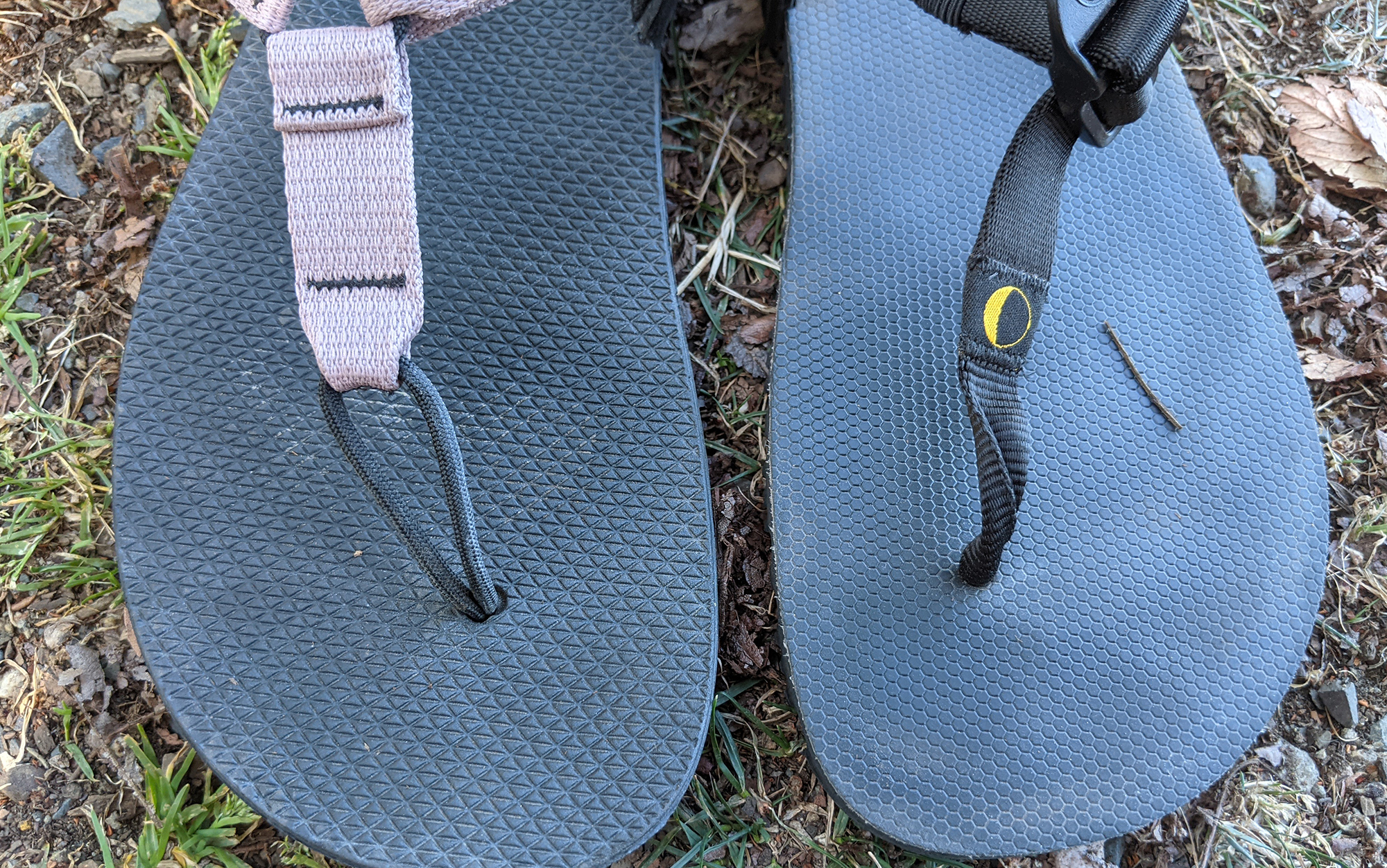
While you absolutely can use the Luna Middle Bear Sandals for river crossings, it’s got some very slight disadvantages for this purpose compared to the Bedrock Cairns. The first is that, while you can adjust the length of the back heel strap, it takes a bit of effort to get it to move through the ladderlock buckle on the sides. I also found that the webbing used for the Y-straps tends to twist around, although it’s not uncomfortable in the way that hard plastic Y-straps are uncomfortable. But these are all minor quibbles. These are a great choice for camp shoes that can be used for a wide range of purposes.
After wearing a number of barefoot-style sandals over the last year, the Lunas have ultimately become my go-to. They are simply more comfortable, more secure, and more durable than the competition from Bedrock and Xero. If you are looking for a multi-purpose camp sandal — one that can kick quickly and take out on long hikes, river crossings, and more — it would be hard to do better. And most importantly, you’ll still want to put them on at the end of a long day.
Classic Pick: Crocs Classic Clog
Pros
- Cushy and comfortable
- Affordably priced
- Wide range of available sizes and colors
Cons
- Not appropriate for water crossings
Key Features
- Available Sizes: Men’s 4-17; women’s 6-12
- Materials: Thermoplastic (EVA)
- Weight: 10.9 ounces
- Minimal arch support
Crocs are one of the most popular camp shoes out there, and for good reason. They are cushy and comfortable. They are essentially waterproof, yet also breathable. They slip on easily, and have a roomy base that can accommodate a wide range of foot shapes. The Crocs Classic Clog is popular with just about everyone: backpackers, overlanders, car campers — you name it. There is no more common shoe to see in the outdoors.
After comparing the Crocs Classic Clog and the Merrell Hydro Mocs, my take is that backpackers are better served by the Hydro Mocs. The addition of the back heel doesn’t make it any harder to slip on this shoe compared to the Crocs, and does make it substantially better for water crossings. I also found that the small bumps on the Crocs were less comfortable than the smooth footbed of the Hydro Mocs.
Similarly, I think that car campers and overlanders would be better served for the long haul by Birkenstocks, which are similarly comfortable but better for the overall ergonomics of your foot.
It’s recommended that you size up a half size when choosing a pair of Crocs Classic Clog as a camp shoe.
Best for River Crossings: Vivobarefoot Ultra III Bloom
Pros
- Very breathable
- Fast drying
- Extra-wide width will accommodate virtually all feet
Cons
- Zero-drop and lack of cushioning may be less comfortable for some
- Laces are somewhat less durable than the rest of the shoe
Key Features
- Available Sizes: Men’s 7-15; women’s 5.5-11.5
- Materials: EVA foam; Bloom foam
- Weight: 12.6 ounces
- No arch support
I’ve used the Vivobarefoot Ultra III Bloom extensively on everything from car camping trips to whitewater rafting and I’m consistently impressed by its performance in a multitude of settings. I’m plenty comfortable hiking short distances in it; it also feels great after a long day when my feet are wrecked from hiking. I like that it’s both breathable and secure (the laces can be tightened down), making it an excellent choice for watery adventures where you want to make sure your shoe stays put on your foot no matter what.
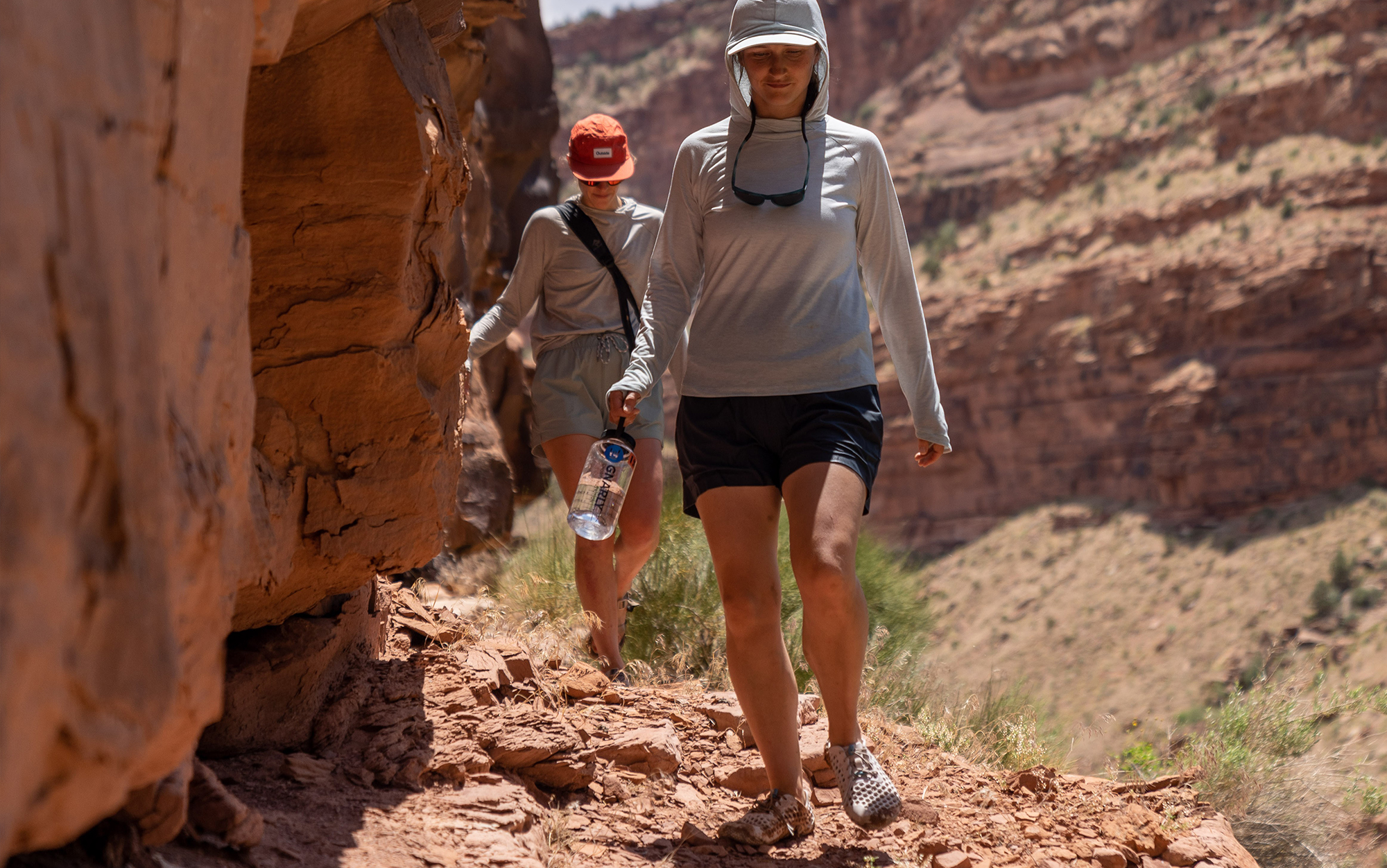
What makes these camp shoes different from others that I looked at is their exceptionally wide fit, well beyond an E. Anyone who has put serious miles on the trail during a backpacking trip knows that your feet have a tendency to swell over time, a combination of your feet retaining water and, on multi-day trips, the ligaments themselves starting to loosen. That’s why so many people recommend sizing up the best hiking boots. It’s also why it feels so great to take them off at the end of the day. Choosing a wider camp shoe, like the Vivobarefoot Ultra III Bloom, can help to give your feet a rest after a hard day of hiking, so that you’re energized and ready to go in the morning.
This camp shoe also has a low stack height with a zero drop. If this is your first zero-drop, low-stack height shoe, keep it as strictly a camp shoe until your feet start to adjust.
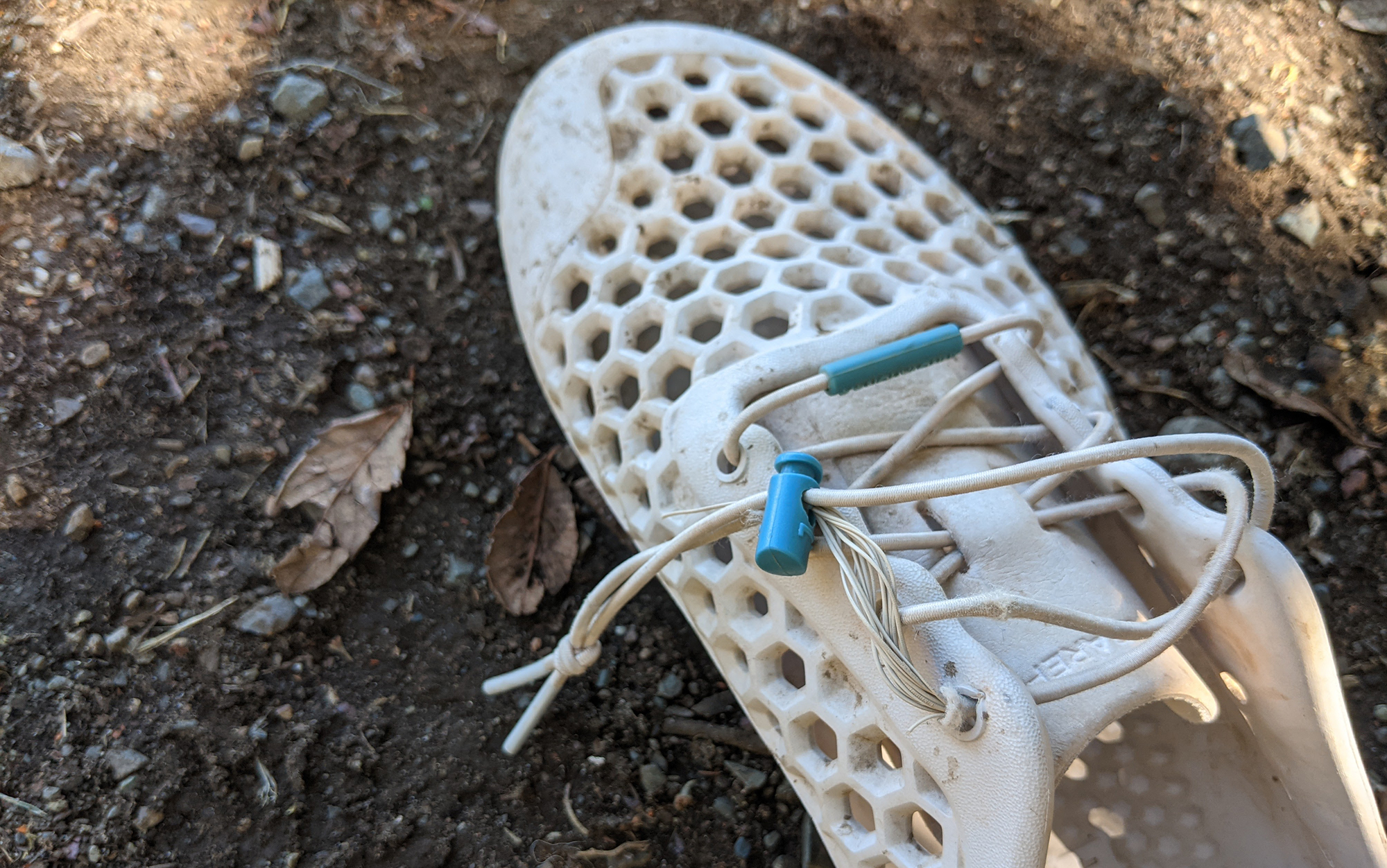
Like our best overall pick, the Vivobarefoot Ultra III Bloom has excellent eco bonafides given that 10 percent of the shoe is derived from algae.
Best for River Trips: Bedrock Cairn Adventure Sandals
Pros
- Very comfortable Y strap
- Easily adjustable
- Can be used for water crossings and some hiking
Cons
- A little heavy
Key Features
- Available Sizes: Men’s 5-14; women’s 6-14
- Materials: polyester/nylon (upper webbing), Vibram rubber (outsole)
- Weight: 15.2 ounces
- No arch support
The Bedrock Cairn Adventure is the sandal that finally convinced me that the toe thong style didn’t need to be so uncomfortable. Like just about everyone else who has ever worn a flipflop, I’ve dealt with blisters popping up in between my toes that made it virtually impossible to walk. But with the Bedrocks, not only did I not get any blisters, I barely even noticed the toe thong. Instead, I was able to focus on how comfortable and secure the sandal was.
The footbed on the Bedrocks is much more textured than the Luna. This is great if you are dealing with watery conditions and want to make sure your foot doesn’t slide around. It’s not great if you need to walk more than half a mile, as the underfoot starts to feel a little chafed. All this makes sense given Bedrocks original evangelists: river rafting guides.
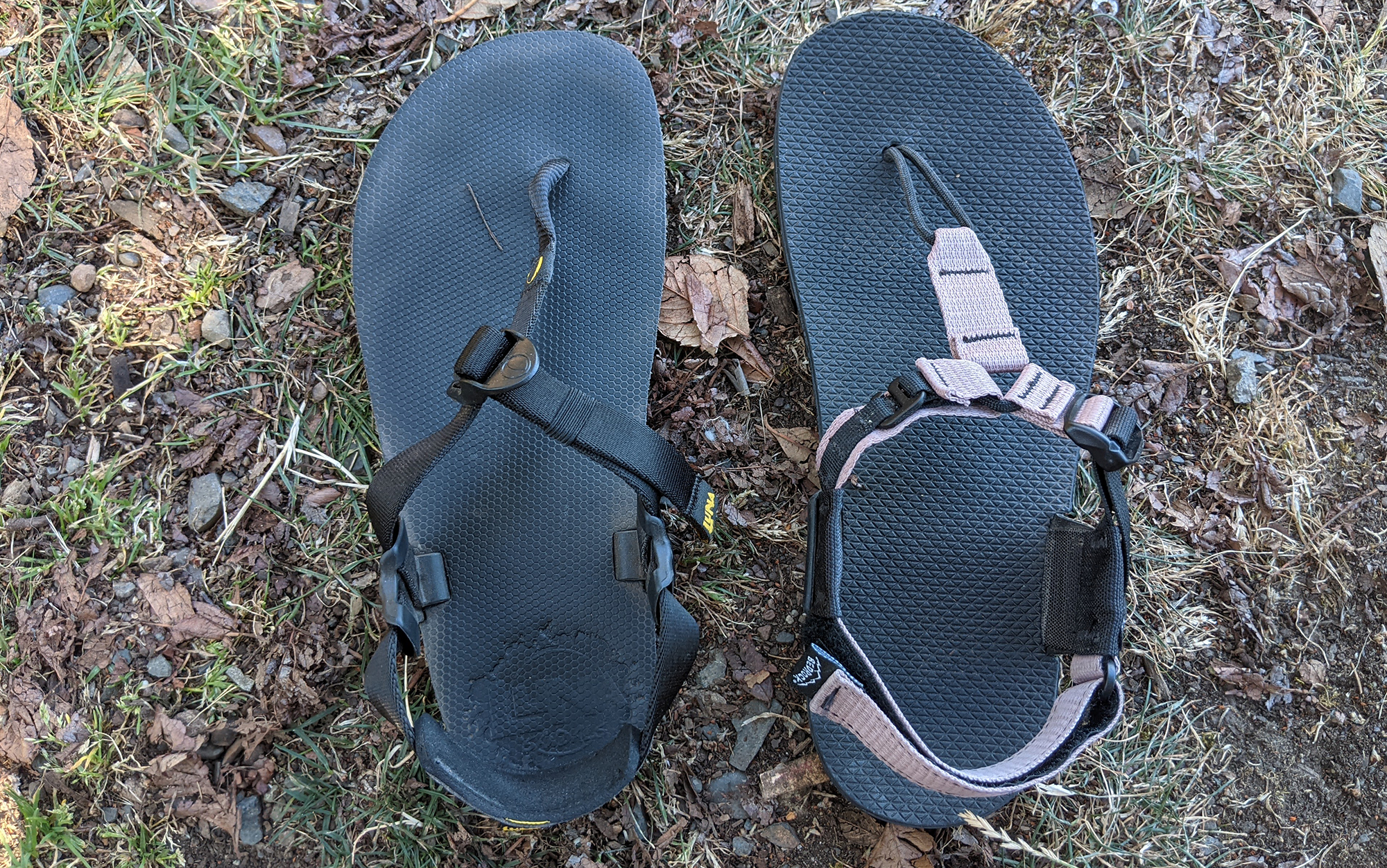
If I’m choosing a camp shoe as a backup for soggy days or river crossings, then I’d choose the Bedrock Cairn Adventures. I was also impressed by how the Velcro on the back heel adjustment point makes it easier to get a secure fit. All in all this is a great sandal, if not the one I would choose as my go-to for day to day adventuring.
Best for Winter: North Face ThermoBall Traction Mule
Pros
- Warm
- Soft and comfortable
- Good traction
Cons
- Not versatile
Key Features
- Available Sizes: Men’s 7-14; women’s 5-11
- Material: ThermoBall Eco insulation, Recycled P.E.T. ripstop upper with non-PFC durable water-repellent (upper), 20 percent recycled rubber (outsole), Oso fleece (collar)
- Weight: 14 ounces
- No arch support
Popular in ski resort parking lots and shoulder season camping, these insulated, water-resistant slippers are great for navigating an icy trip to the bathroom or cozying up by the fire. I took these to a ski in and out yurt as my only shoes besides ski boots this winter. At 14 ounces, they were a lightweight and utilitarian choice. The traction was absolutely necessary to navigate the continuously falling snow outside the hut. And after two years, the traction is still intact. There’s one small tear on the toe but no fluff came out and it appears there’s a woven layer underneath the ripstop containing the insulation.
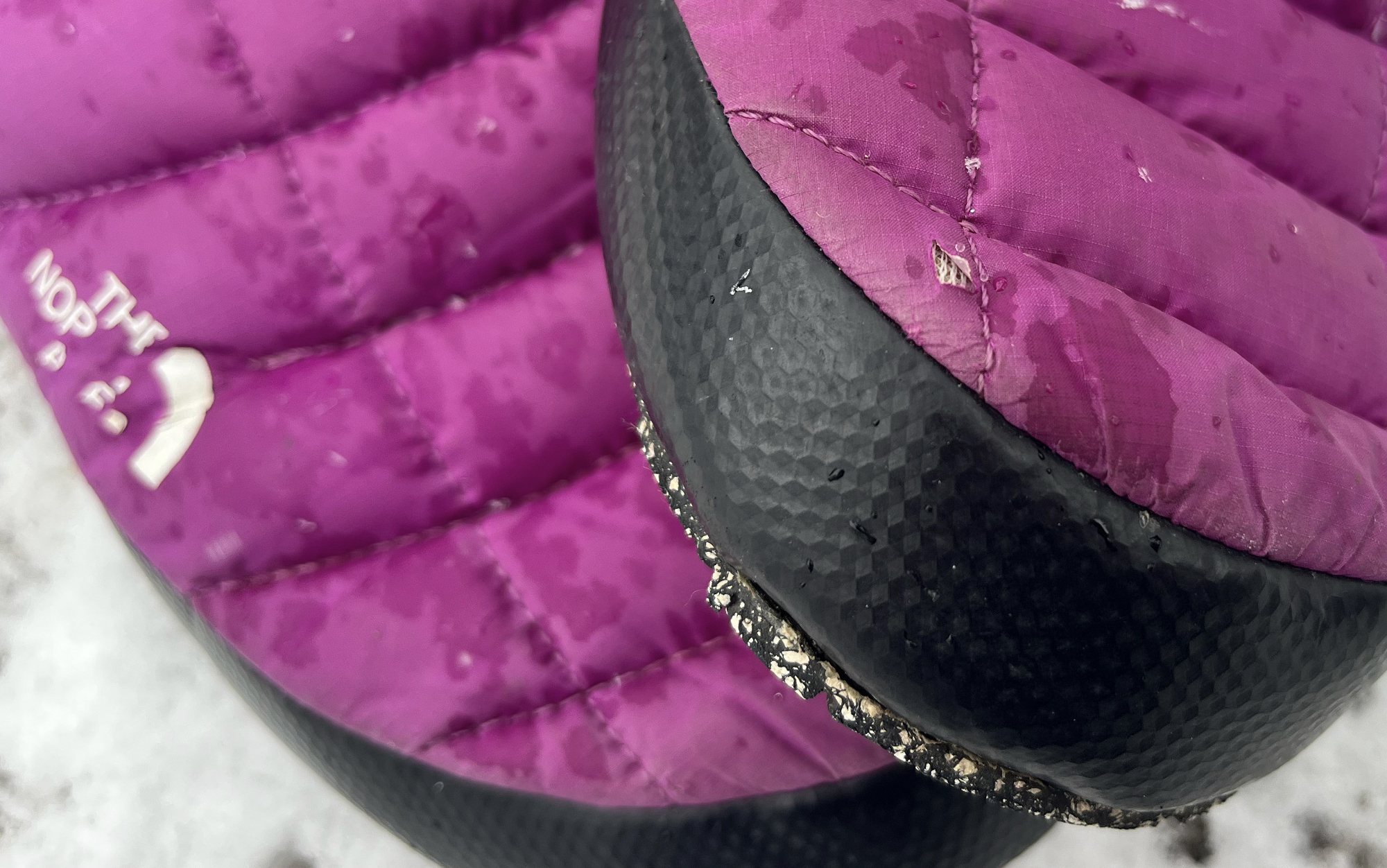
Even on shoulder season trips, these make a cozy camp shoe. If you aren’t planning on crossing any creeks or doing any hiking in your camp shoes, these are a fuzzy and ultra-comfortable choice. They slip on and off easily and feature a collapsible heel. But thanks to the back strap, they won’t fall off your feet. The DWR coating keeps most water from penetrating inside, but the insulation holds its warmth even when damp.
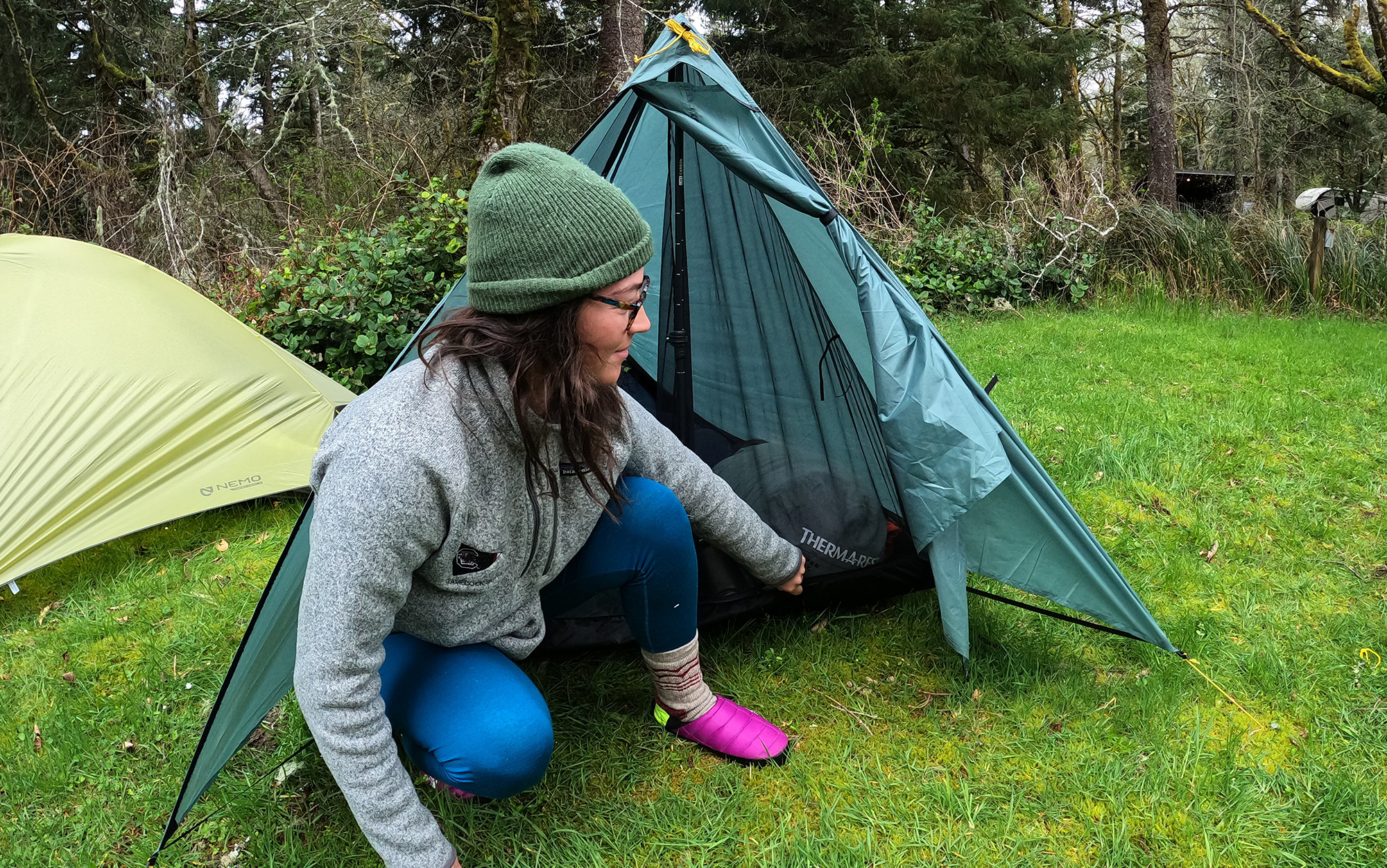
They also come in bootie form to keep out snow, but I love being able to lazily stuff my feet in like slides. The elastic back pops right back up for a secure fit in sport mode, too.
Forever Pick: Birkenstock Arizona
Pros
- Comfortable with an ergonomic fit
- Resoleable
- Slips on easily
Cons
- Not as comfortable when wet
Key Features
- Available Sizes: Men’s 6-17.5; women’s 4-12.5
- Material: Birko-Flor Nubuck (upper), leather (insole), cork (footbed), EVA (outsole)
- Weight: 16 ounces
- Moderate arch support
I’ve had the same pair of Birkenstock Arizonas for over twenty years. I wore them as a kid; I wore them in college. At one point the rubber sole wore out and started eating into the cork footbed, so I had them resoled. Then I kept wearing them. No matter what style shoe I use for running or hiking, from full-fledged boots to minimalist trail runners, the Birkenstock Arizonas always feel like a relief to slip onto my feet after a long day.
I love to take my pair camping. While the cork footbed used to feel comfortable when it got wet, that’s starting to dissipate as they age. Birkenstocks only get more comfortable as they conform more to your foot and the cork footbed smooths out. Other shoes may come and go in my car camping and backpacking setup, but the Birkenstock Arizonas are for life.
Best Budget: Generic Flip Flops
Pros
- Real cheap
- Lightweight
Cons
- Not durable
- Should not be used for hiking or water crossings
- Plastic bits between the toes can sometimes chafe
Key Features
- Available Sizes: Roll of the dice at the gas station
- Materials: Probably plastic
- Weight: Surprisingly lightweight
- Arch Support: Forget it
Unless you are walking around camp in bare feet or nothing but socks, there is no lighter (or cheaper) camp shoe than the generic flip flop. You know the kind I’m talking about: they come from Walmart, or maybe a well-stocked gas station. The pattern on them isn’t really to your taste, but you just needed something—anything—to give your feet a break so that you didn’t have to tromp around everywhere in heavy hiking shoes.
For backpackers, these are a win because they are cheap and they are lightweight—even lighter than the Crocs Classic Clog and the minimalist sandals we checked out. For car campers and overlanders, it’s more about the convenience. If you forget to check your camping checklist and accidentally leave your camp shoes at home, they can be picked up from almost anywhere. That’s why we all have three pairs of them in our closet.
The only thing I don’t love about those cheap generic flip flops is that plastic connection piece between the toes. It’s both uncomfortable (why is there always a serrated ridge there?) and the most common failure point.
Vibram Furoshiki
Pros
- Unique closing mechanism means that it can perfectly fit almost any size foot
- Soft and comfortable material
- Heel cups feels secure without feeling tight
Cons
- Not as breathable as I would have liked
- Not protective enough to walk any kind of distance
Key Features
- Available Sizes: Men’s 8.5-14, women’s 5-10.5
- Materials: Nylon, polyester, spandex (upper), Vibram rubber (outsole)
- Weight: 11.6 ounces
- No arch support
Let’s start with how Vibram Furoshikis work, because it’s very different from a typical lace-up shoe or sandal, let alone a camp shoe. When opened, there is a lightly cushioned heel cup at the back and a very loose piece of fabric at the front for your toes to slide into. On either side are two loose strips of fabric that you pull diagonally over each side, securing at the heel with Velcro.
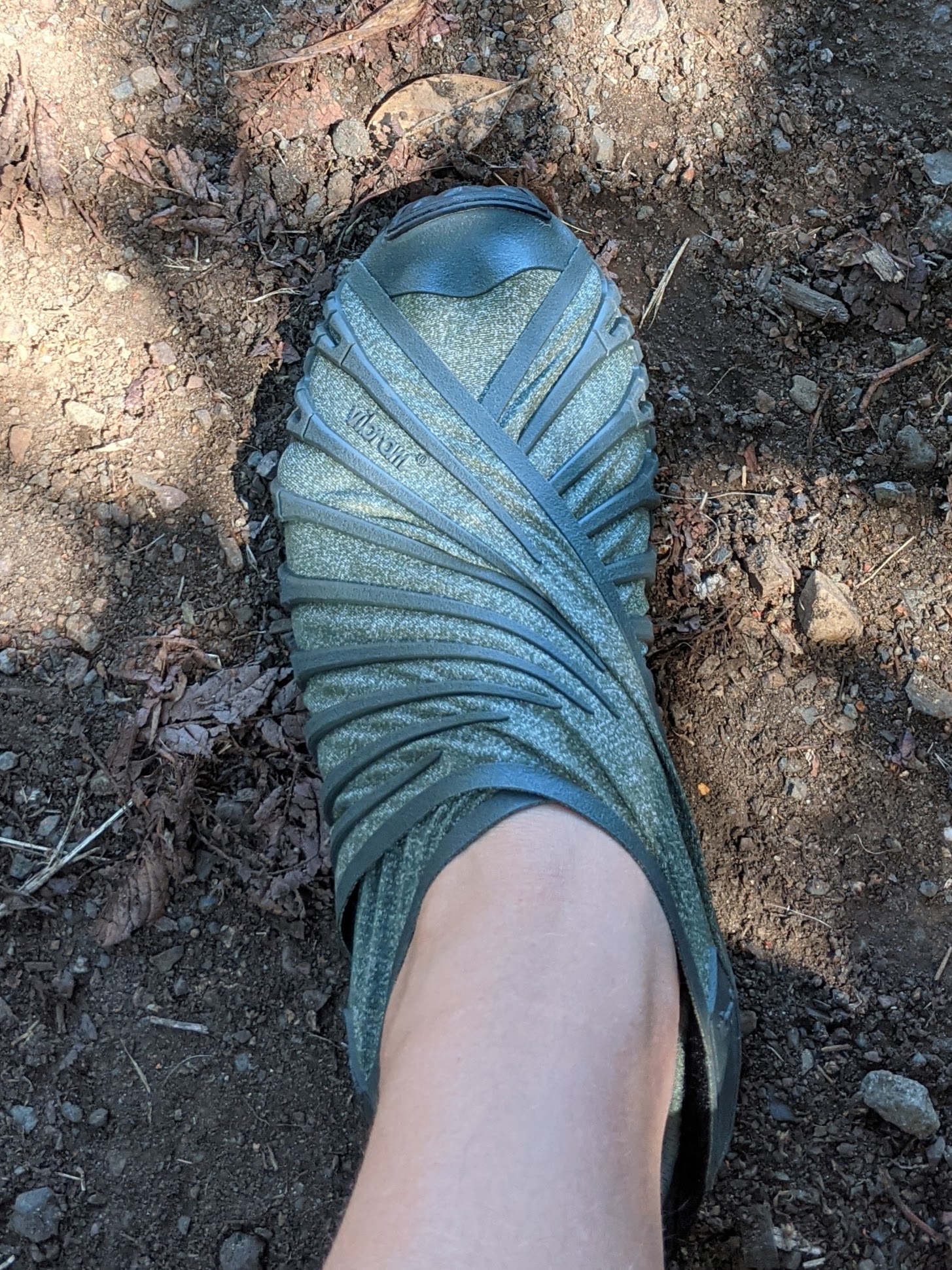
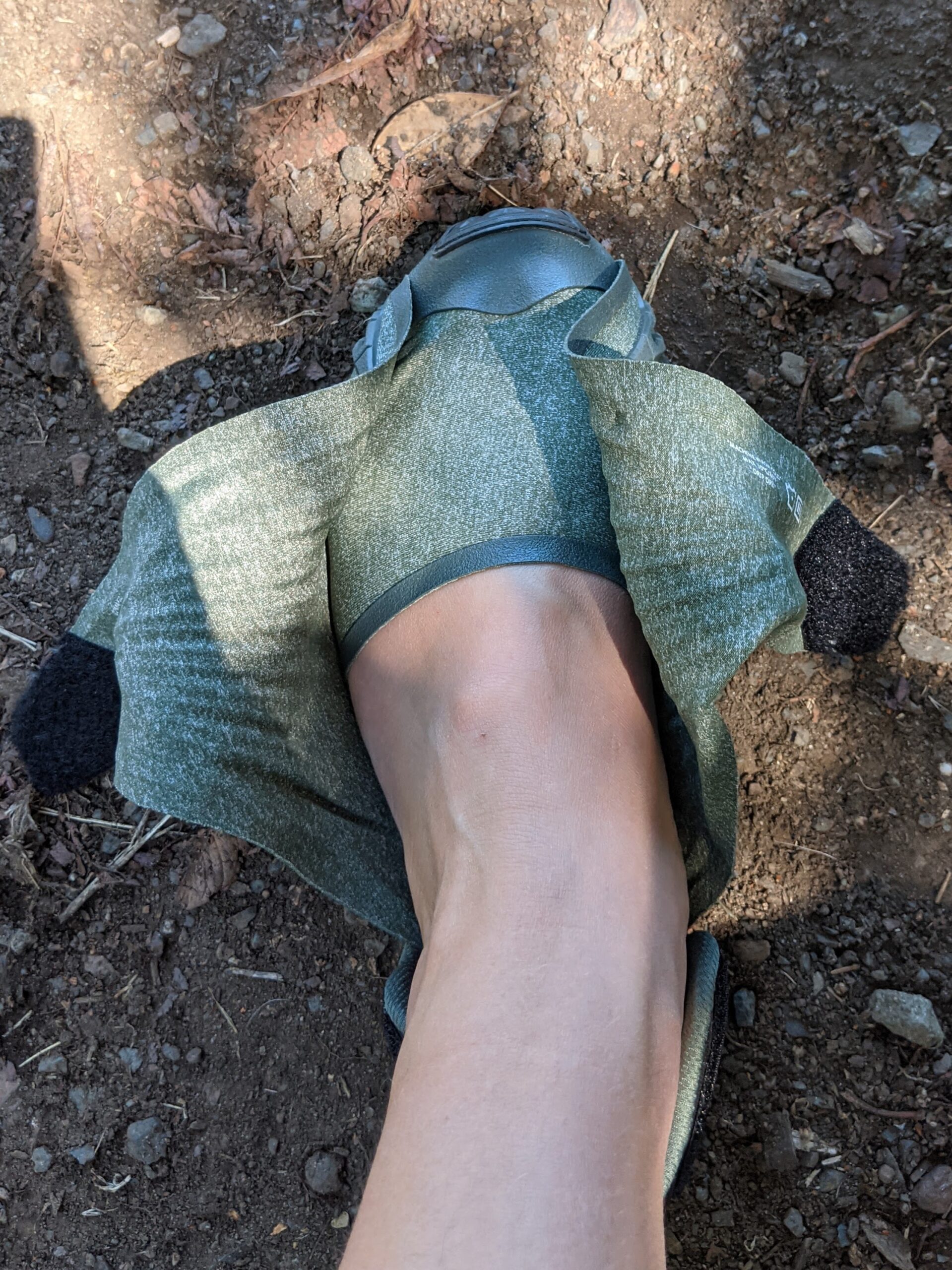
The advantage of this closure system is that it conforms to just about any foot shape or size you can dream up: a boon for backpackers on their second week when their feet have inexplicably grown an entire size. It also gives you some control over the level of compression: if a more tightly wrapped fit sounds like it would feel good at the end of a long day you can do that. Or you can secure it more loosely to give your feet extra room to breathe.
I also liked that the wrapping material (a combination of Lycra and polyamide) was soft and smooth to the touch: putting these on felt like pampering my feet. The Vibram outsole had the characteristic grip you would expect while also being surprisingly lightweight. I liked these shoes so much, in fact, that I experimented with hiking around in them. Unfortunately, they were not breathable enough (or warm enough) to make this a realistic option in the vast majority of circumstances. While they could be used for river crossings, the slightly thick insole means that it will take longer to dry, while the narrower toebox (especially compared to the renowned Vibram Fivefingers) means it will have reduced stability for that purpose.
Oboz Whakata Puffy Slippers
Pros
- Provides some insulation for colder climes
- Most protective and durable sole I looked at
- Heavy-duty toe guard
- Crushable heel means you can treat these like slippers
Cons
- Heaviest camp shoes I looked at (over a pound)
Key Features
- Available Sizes: Men’s 8-13, women’s 6-11
- Materials: Cordura (fabric), Primaloft Bio (insulation)
- Weight: 18.2 ounces
- Minimal arch support
If weight is no object, then this is easily the most comfortable camp shoe I tested. The inside is warm, soft, and cozy, with just enough extra width to account for wide feet, but will feel great even if you have a more typical width foot. It’s also very protective. It has a thick sole made out of a combination of plastic and rubber (with a Bloom midsole). Even though its stack height was easily the highest in my test, its overall width meant that it wasn’t tippy. It also has a toe guard, protecting you from inadvertent bangs against rocks when nature calls in the middle of the night. If you have blisters on your foot at the end of a long day in hiking boots, never fear: the crushable heel means you can wear these as if they were sandals.
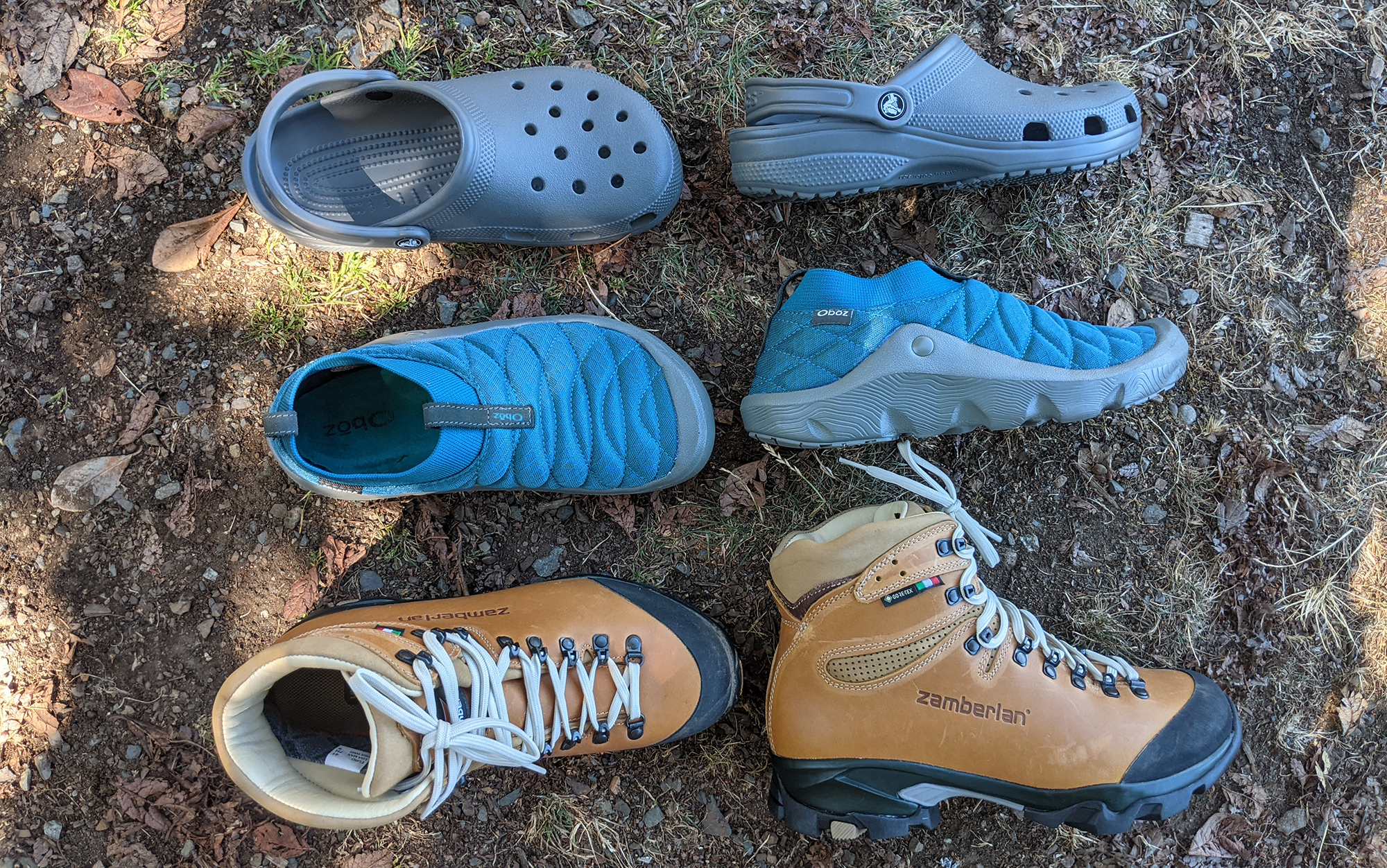
The downfall of these is the weight: at over one pound they aren’t a realistic choice if you are hauling everything in on your back. But if you’re rafting, horse-packing, or just plain old car camping, these are hard to beat.
Fit notes: Runs small—size up a half to a full size for a roomier fit.
How to Choose the Best Camp Shoes
Comfort
The first and most important feature of a camp shoe is its comfort. After a long day of hiking, your dogs deserve a break. While I have indicated in the above review which camp shoes were more or less cushioned, had more or less support, comfort is ultimately a subjective metric, and you will need to consider for yourself what would feel best for your feet at the end of a long day of hiking.
Versatility
While the first and foremost purpose of a camp shoe is to give your feet a break from your hiking boots or shoes after a long day on trail, many backpackers look for other uses for their camp shoes. The most common is as a shoe for river or other water crossings. If you want to use your camp shoe as a river crossing shoe, look for something that sheds water, like the Merrell Hydro Mocs or Vivobarefoot Ultra III Blooms. It’s also important to choose a camp shoe with a closed toe box when looking for something to protect your foot in murky water.
Some backpackers also look for their camp shoes to be a backup for hiking in. There are a variety of reasons for this, but the most common is that someone’s hiking boots or shoes are simply uncomfortable or are consistently causing blisters. However, rather than planning to hike in your camp shoes, a better strategy would be to deal with the discomfort head on, either by switching to a pair of the best trail runners, which are significantly less likely to cause blisters due to their breathability and flexibility or by looking into solutions for the blisters once they have occurred.
Read Next: Should You Pop a Blister When Hiking?
Weight
Carrying an extra pair of shoes can add significant weight to your overall backpacking kit if you aren’t careful. Check the weight of the pair you are considering before making a final choice.
FAQs
Camp shoes are typically used by backpackers looking to take a break from the best hiking boots or the best hiking shoes at the end of a long day. They are also used by campers and other outdoors people looking for a shoe they can slide into and out of easily while at camp.
Sandals are a great choice for camping, as they maximize breathability and don’t constrict your feet, which can swell after extensive hiking or in hotter climates.
You can hike in some, but not all, camp shoes, depending on the distance you are planning to travel. Camp shoes that should not be used for hiking include flip flops and Birkenstocks, as they will slide around too much on your feet. You can hike for very short distances on flat, stable surfaces in shoes like Crocs, Merrell Hydro Mocs, Vibram Furoshikis, Oboz Whakata Puffy, and Vivobarefoot Ultra III Blooms. If you are accustomed to hiking in the best minimalist shoes, you can hike in the Luna Middle Bear Sandals or the Bedrock Cairn Adventure Sandals.
Final Thoughts on the Best Camp Shoes
Camp shoes are one of the most common luxury items for backpackers for good reason: It just feels so good to kick off your hiking boots or shoes at the end of a 20-mile day. If you’ve been considering adding a pair to your arsenal, check out the below options to see which is the best fit for your needs:
Best Overall: Merrell Hydro Moc (Men’s) (Women’s)
Lightest: Xero Z-Trail EVs (Men’s) (Women’s)
Best Sandals: Luna Middle Bear Sandals (Unisex)
Classic Pick: Crocs Classic Clog (Unisex)
Best for River Crossings: Vivobarefoot Ultra III Bloom (Men’s) (Women’s)
Best for River Trips: Bedrock Cairn Adventure Sandals (Men’s) (Women’s)
Best for Cold Weather: The North Face ThermoBall Traction Mules (Men’s) (Women’s)
Forever Pick: Birkenstock Arizona (Men’s) (Women’s)
Best Budget: Generic Flip Flops (Men’s) (Women’s)
Vibram Furoshiki (Men’s) (Women’s)
Oboz Whakata Puffy (Men’s) (Women’s)
The post The Best Camp Shoes of 2025 appeared first on Outdoor Life.


